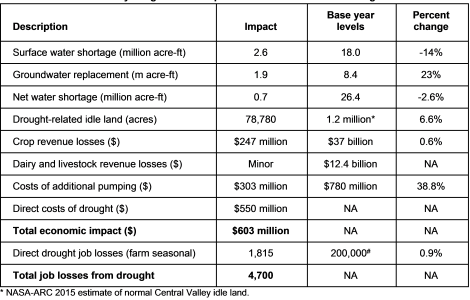From: UC Davis Center for Watershed Sciences (California Water Blog)
by Josué Medellín-Azuara, Duncan MacEwan, Richard E. Howitt, Daniel A. Sumner, and Jay R. Lund
![]() The drought continues for California’s agriculture in 2016, but with much less severe and widespread impacts than in the two previous drought years, 2014 and 2015. Winter and spring were wetter in the Sacramento Valley, to the extent of several reservoirs being required to spill water for flood control, but south of the Delta was unusually dry. The much-heralded El Nino brought largely average precipitation north of the Delta, replenishing some groundwater, and drier than average conditions to the southern Central Valley and southern California. The historical pattern of increasing water exports from the Sacramento-San Joaquin Delta in these circumstances was less available due to environmental restrictions on Delta pumping. Some concerns also remain for water supplies north of the Delta regarding temperature releases from Shasta reservoir. The overall estimated impacts of the 2016 drought on agriculture are summarized in the table below.
The drought continues for California’s agriculture in 2016, but with much less severe and widespread impacts than in the two previous drought years, 2014 and 2015. Winter and spring were wetter in the Sacramento Valley, to the extent of several reservoirs being required to spill water for flood control, but south of the Delta was unusually dry. The much-heralded El Nino brought largely average precipitation north of the Delta, replenishing some groundwater, and drier than average conditions to the southern Central Valley and southern California. The historical pattern of increasing water exports from the Sacramento-San Joaquin Delta in these circumstances was less available due to environmental restrictions on Delta pumping. Some concerns also remain for water supplies north of the Delta regarding temperature releases from Shasta reservoir. The overall estimated impacts of the 2016 drought on agriculture are summarized in the table below.

Courtesy of UC Davis
Survey work on expected surface water deliveries to agricultural water districts, and public announcement from main water contractors indicate a surface water shortage of 2.6 million acre-foot of water for agriculture during the 2016 irrigation season mostly for the Central Valley. This is roughly 14 percent less than a normal statewide surface water supply for crops. This shortage is reduced with nearly 1.9 million acre-foot of additional groundwater pumping for a net water shortage of 0.7 million acre foot or 2.6% of the estimated applied water in agriculture.
With this water shortage, about 78,800 acres of land could be idled due to drought, a small proportion of California’s 9.3 million acres of irrigated crops. Almost all fallowed land due to drought is projected to be on the west side of the San Joaquin Basin which relies heavily on water imports. No significant drought related impacts are expected for livestock and dairies this year as this sector is more affected by market conditions than drought this year. Net water shortages will cost about $247 million dollars in forgone gross crop revenues plus $303 million in additional pumping costs for a total of $550 million in direct costs and 1,815 jobs lost in agriculture due to drought. Region-wide effects which include sectors supporting agriculture face gross revenue losses and households lost income of an estimated $603 million and 4,700 jobs statewide.

Groundwater is responsible for offsetting about 70 percent of the statewide surface water shortage for agriculture. The energy cost of this additional pumping equals $300 million, exceeding estimated crop losses due to drought. The progressive depletion of groundwater during the drought also has increased costs for rehabilitation and replacement of domestic and agricultural wells.
Environmental issues from fish stocks further weakened by earlier years of drought have left irrigation district managers concerned about the potential for late-season curtailments to manage reservoir water temperatures for fish habitat. Delta environmental water operation constraints this year have prevented additional through-Delta water transfers, effectively shutting down the 2016 water market across the Delta. Water transfers from the Sacramento Valley to the San Joaquin Valley helped offset some of the economic cost of the 2014 and 2015 drought.
Pasture conditions and feed market conditions have improved for livestock producers, but low cattle and milk prices place intense economic pressure on producers.
Groundwater reserves and national and global market conditions continue to support the health and robustness of areas of California’s agriculture still affected by water shortages. Modest recovery in contract labor growth from 2014 to 2015 is apparent from labor statistics due to favorable market conditions for California’s commodities. Water management in the Sacramento San Joaquin Delta for protecting endangered species and access to groundwater remain important for sustaining water supply for California’s agriculture and related sectors. A better accounting of water use and water reserves along with other management tools will facilitate groundwater management, water market transfers, and overall water management and policy for drought.
These results were developed by this team of researchers from UC Davis Center for Watershed Sciences, ERA Economics and the UC Agricultural Issues Center for their third drought economic impact assessment on agriculture commissioned by the California Department of Food and Agriculture.
Further Reading
2016 Study Downloads
- Executive Summary (<1Mb, Posted August, 15, 2016)
- Main Report (<1Mb, Posted August, 15, 2016)
- Appendix Set (23 Mb, Posted August 15, 2016)
Josué MedellínAzuara, Duncan MacEwan, Richard E. Howitt, Daniel A. Sumner, and Jay R. Lund (2016), Economic Analysis of the 2016 California Drought on Agriculture, A report for the California Department of Food and Agriculture, with research support fromJennifer Scheer, Robert Gailey, Quinn Hart, Nadya D. Alexander, Brad Arnold, Angela Kwon, Andrew Bell and William Li, Center for Watershed Sciences, University of California – Davis, August 11, 2016.










